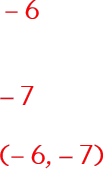There's more than one way to skin a cat. EWWWW! Okay, we aren't skinning cats here but you may have heard that old proverb before…So, there's also more than one way to find the vertex of a quadratic function! My feeling is always, find the method that best works for Y-O-U! Personally? I think this is a much EASIER way to find the vertex because, a) I can always re-write the equation into this form using all those lovely properties (you know the ones: Associative, Commutative, Distributive…) and b) it seems to be a more VISUAL form and when things are in a visual form, they are obviously easier to SEE. I'm sure lots of folks will disagree but that's okay. You decide. |
||||
 |
||||
The 'vertex' form for writing a quadratic function looks like this.
Let's see what this looks like when it applies to some 'real' functions. |
||
Find the vertex of this parabola. |
||||
Finding the Vertex Step 1: Find the vertex of the parabola
|
||||||||
Step 2: Determine if the parabola opens up or down (minimum or maximum point)
|
||||||||
 |
||||
That's it! Easy-peasy, lemon-squeasy! |
||||
Are you ready to try a few other functions to see how it works? Come on! We'll even see how to go from the STANDARD form to the Vertex Form…totally awesome. |
||
Here's the problem: |
||||
Step 1: Find the Vertex
|
||||
 |
||||
Step 2: Determine if the parabola opens up/down and has minimum/maximum vertex
|
||||
 |
||||
 |
||||
Relax! If the function is not in this Standard form but is in the regular ol' quadratic function equation form (you know the one, y = ax2 + bx + c), then you can easily put it INTO Standard Form by doing what's called 'COMPLETING the SQUARE.' Completing the square is a form of factoring, which, of course, we've done a LOT of. Go on to the Completing the Square now, if you need some help. |
||
©2011–2017 Sherry Skipper Spurgeon. All Rights Reserved. |
||
